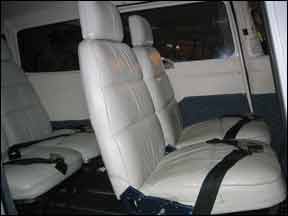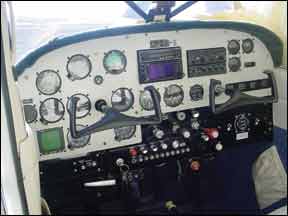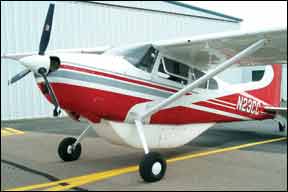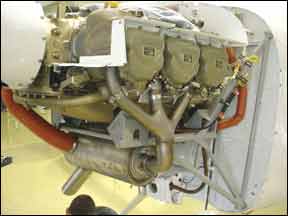In an age when the majority of new airplanes are made of plastic and equipped with glass panels and envelope-protected autopilots, it’s hard to imagine that as recently as 1985, at least one company was still making a popular taildragger. But it was.

That company was Cessna and the airplane was the 185. It’s no stretch to say that if the Skywagon was popular then, it may be even more in demand now, given the prices the latest models fetch on the used market.
Cessna 185 owners don’t just like these airplanes, they rave about them. It’s not hard to understand why, either. No newer airplanes will do what Skywagon can, in terms of load hauling and taildragger ruggedness. You’ll see Cherokee Sixes plying gravel strips in Alaska, but you’ll see many more 185s.
There are lots of other working airplanes, but the Cessna 185 is perhaps unique for its reputation as the airborne version of a four-wheel-drive, three-quarter-ton pick-up truck, easily able to haul heavy loads into and out of short, unimproved strips. With plenty of power and two front cabin doors, it’s also a prized floatplane. And for all of that, some owners just like them for fun flying.
SKYWAGON ORIGINS
The 185 was a thoroughly logical development in the Cessna product line, which began with the taildragging 120, evolved to the 170 and 180 and then, when owners indicated the need for something bigger, the 185. It came along in 1961, a follow-on product to the Cessna 180, which enjoyed considerable popularity. But don’t forget, by 1961, the tricycle gear revolution was we’ll established. The 172 and 182 were out there and so was the 210, the 206 soon to follow.
Outwardly, the 180 and 185 evolved into virtually identical-looking airplanes, with comparable overall dimensions and major parts. The primary difference, of course, is the engine. The 180 had a 230-HP Continental, which was adequate but didn’t elevate it to the status of a super load hauler.
When the 185 debuted in 1961, it had a 260-HP Continental IO-470F and 84-gallon fuel tanks and could perform the rather remarkable feat of lifting more than its own weight: The useful load of 1680 pounds is about 200 pounds more than its standard empty weight, something bush operators prized. Locked securely in the utility market, the 185 was spared some of the cosmetic “improvements” applied to nosewheel Cessnas. It never got the swept-back tail, for example, or the rear window that was added to the nosewheel line. Buyers bought it for what it did, not for how it looked. Unfortunately, it also never got the fuselage “bulge” applied to some of the nosewheel line, leaving the cabin a little tight at 41 inches wide.

However, you could order a new 185 with Edo floats, a massive belly cargo pod that could accommodate 300 pounds or a spray application rig, to name a few options. Towing set-ups and flip-up doors for skydiving operations were also available.
Anyone who hauls stuff for a living always wants more power, so in 1966, Cessna replaced the IO-470F with a 300-HP Continental IO-520D as an option. The 300-HP Skywagons are called A185s.
The bigger engine improved the 185’s already exceptional performance. For a mere 10-pound increase in empty weight, the airplane received a 150-pound increase in gross, five more knots of cruise speed and some 200 feet was shaved off the takeoff ground roll, a boon for back-country operators. The engine was such a hit that it was made standard in 1967.
Also new that year was the addition of an aft baggage compartment, along with an optional stretcher door, both of which made loading bulky objects easier. From 1972 through 1979 you could order a full aerial application rig, with belly tank and spray booms. The package turned the airplane into the “AgCarryall.”
In 1973, a new cuffed leading wing profile was introduced. The so-called camber lift wing was created by Robertson as part of a STOL kit for the Cessna line and it reduces stall speed slightly, improving roll control at low speeds. Since it’s a leading edge mod, Robertson can retrofit it to earlier 185s. The cuffed leading edge is much prized among float operators.
The re-winged 185 became the A185F, which is by far the most numerous variant, accounting for more than half of all airframes. As of 2012, the FAA registry shows 1784 185s of all models; 1224 are A185Fs.
More work-related options came along in 1975, including bubble side windows for photography and skylights. In 1976, flap-extension speed (Vfe) went from 96 to 120 knots and the fuel selector was changed to Cessna’s all but idiot-proof left-right-both arrangement. Lift handles were added to the tail to give ground handlers a safe means to muscle the airplane on the ramp without damaging the stab. One change that was a mixed blessing was the reduction in usable fuel from 81 to 74 gallons, which cut into the airplane’s range.
The 1979 models had a new wet wing fuel system with 88 gallons, 84 of which is usable. The older bladder-style tanks were optional. While the bladders had less potential for leakage, they had other problems, as we’ll note in the maintenance section.

The original Skywagon had a two-blade prop, with the three-blade version surfacing as an option in 1978 and becoming standard in 1980. The three-blade can be retrofitted. Owners report no cruise speed loss. It also reduces vibration and noise and climb is said to be better, plus it looks undeniably sexier.
The 185 enjoyed brisk if not spectacular production numbers until 1981, when only 389 were built. By 1984 and 1985, only 34 Skywagons were made as prices shot up and Cessna’s sales went the other way. That the average equipped price of a new 185 nearly doubled, from $55,670 in 1979 to $108,090 in 1985 probably didn’t help. Today, a good used one of early- to mid-80s vintage will bring between $150,000 and $180,000. Some sellers demand a lot more for one tricked out in glass or floats.
PERFORMANCE, HANDLING
Given the performance of retracts equipped with the IO-520, the Skywagon won’t set any speed records, but few of them will do what the 185 can: Fly with full tanks, full seats and baggage. Load a Skywagon with full fuel, four 220-pound people and perhaps 50 pounds of bags, and the airplane will take off in just over 800 feet, climb at better than 1000 FPM and then fly 800 miles at 140 knots, outdistancing a handful of retracts and twins. Even at higher altitudes, the IO-520 has plenty left.
Fuel flows range around 14.5 GPH, rich of peak, depending on power setting. Installing GAMIjectors and operating lean of peak will pay for itself with fuel savings and engine longevity with only a moderate loss of cruise speed. We always wondered why Cessna never hung a turbocharger on the 185, as it would seem to have made a great deal of sense for the mountain operators. Tornado Alley Turbos will turbonormalize your 185, and owners report cruise speeds of 165-175 knots at FL200 while burning 14.5 GPH.
In stock form, the 185 is nearly a STOL airplane. With those big barn door flaps at 40 degrees, stall speed is under 45 knots so 55-knot approach speeds are doable. We’ve been told of skilled bush pilots plunking the Skywagon down in as little as 300 feet in a rough clearing or river sandbar.

As with any airplane, the technique is a high-alpha approach with flaps and power at a speed between 50 and 55 knots, followed by a full-stall three-pointer. Watch the aggressive braking, however, since the airplane can and will nose over with locked wheels.
Although the airplane handles we’ll in the air, some owners say it’s not easy to land and won’t tolerate lazy feet on the rudder, especially in crosswinds and the accident reports confirm the assessment. Yet as taildraggers go, it’s not overly twitchy and the deck angle allows seeing over the nose so S-turns aren’t necessary.
Wheel landings, while doable, require some finesse due to the 185’s spring-steel landing gear legs. If the pilot doesn’t convert a botched wheelie into a three-pointer, loss of control may follow. Most owners seem to prefer three-pointers, which are aided and abetted by the locking tailwheel, which also helps in crosswinds. Just don’t forget to unlock it before taxi turning, otherwise you risk tire damage on the tailwheel.
In the air, handling of a Skywagon is similar to another Cessna product, the Skylane. Trim, unlike that on most Cessnas, is through a jackscrew in the tail rather than via a trim tab, and the system’s low gearing means you move the wheel a bit before noticing the effect.
Cessna didn’t offer electric trim, but some autopilot installations include it and pilots who have it like it better than the manual system. Cessna never offered electric flaps in the 185, either, a real blessing in our view. Manual flaps are simply superior for ease of use—get them down or up quickly with no question of flap position. They’re also more maintenance reliable.
Like most Cessnas, the 185 is susceptible to a trim-induced stall on a full-flap go-around. If the nose-up moment isn’t dealt with via forward yoke and trim, the airplane’s angle of attack will exceed the stall value. It’s better to apply partial power, arrest the sink, then go to 20 degrees of flaps before applying full climb power and retracting the rest of the flaps.
A 185 can haul just about anything you can get into it. But the cabin volume is not all that great compared to a Cherokee Six or Cessna 206. There is no way that anything large will go through the 18- by 20-inch baggage door or the two cabin doors of a 185. On the other hand, the right front door can be removed easily (a mod allows flight with the door off), as can the back seat, but that still doesn’t leave much maneuvering room in the cabin for large objects.

The optional fiberglass belly pod is 9 feet long and 14 inches deep and while huge objects still can’t be loaded, the pod is ideal for awkward cargo such as chainsaws, tool, skis and fishing gear. (Not to mention the smelly fish.)
INTERIOR, MAINTENANCE
Cessna’s marketing photos of the day show interiors with six seats and the airplane was billed as a six-placer. As is typical of such marketing claims, that’s a gross exaggeration. Calling the third row “seating” is generous, except perhaps for a child. The seat is limited to 120 pounds and most owners leave it in the hangar, opening more space for baggage.
An option on later 185s was a pair of articulating seats for the front row, with adjustable height and reclining seat backs. The back on the rear seat was split and it too could recline. The seating position is quite upright, with good head and legroom but not generous shoulder room in a cabin measuring 41 inches in width.
Cessna singles have a reputation for being maintainable as we’ll as durable. That’s the 185 in spades. It’s a derivative airplane, being based on the 180, which was, in turn, a bigger version of the 170. Therefore, Cessna got the flaws hammered out in what was a good airplane from the beginning. Owners tell us to watch these trouble spots: Tailwheel shimmy can be caused by wear of the bolt that holds the fork to the tailwheel spring. Airplanes with McCauley wheels and brakes aren’t as desirable as those with Clevelands, which can be retrofitted.
Mufflers tend to crack after a few hundred hours, so inspect them carefully. Airplanes built before 1981 had trouble with the trim because in cruise, the jack screw needs 300 foot-pounds of torque to move. This stresses roll pins connecting the trim wheel to the chain drive sprocket. If the pins shear, the trim is stuck. Later airplanes replaced the pins with rivets.
Cessna offered shoulder harnesses as options for all seats in all of its singles after World War II, however, safety didn’t sell until the early 1980s and no one ordered them. The good news is that it means retrofitting them is easy; the hard points are under the headliner. From a safety standpoint, especially given the high rate of landing accidents and head injuries to occupants, for the 185, it’s a retrofit we strongly recommend.
As Continental engines go, the O-470 and O-520 series have delivered decent service. In many models, the engine installation is at the root of short engine life but that doesn’t seem to be the case in the 185. It has a roomy cowl and large cowl flaps, so overheating isn’t an issue. Advertised TBO is 1700 hours, which is realistic if the owner is prepared to do a mid-time top overhaul. If the top isn’t needed, consider it gravy.
Give Cessna credit for one thing: It has delivered on parts and support, even in the lean years when no piston production was alive. If flown often and worked hard, expect to replace landing gear boxes now and again, plus tailwheel parts.
The Skywagon is a typical Cessna single, so there are plenty of mechanics around qualified to examine one for pre-purchase and to maintain it afterwards. Of particular note, however, is the possibility of corrosion if the airplane has ever been on floats, as many 185s have. Check the logs for this history. Like any corrosion, it can be expensive to repair, and it’s likely to be there in some form on any aircraft operated on salt water.

MODS, CLUBS
Being a bush and utility favorite, lots of mods are available for the185, some of them also found on other Cessna singles. STOL kits are available from Horton www.hortonstolcraft.com and Sierra www.sijet.com. We have received complaints from owners on STOL kits on the 185 in which the ailerons are drooped with full flaps regarding loss of roll control during crosswind landings, possibly due to misrigging causing a lack of up aileron deflection.
Because VGs do essentially the same as a STOL kit without the weight, we would suggest a VG kit from Micro Aerodynamics www.microaero.com, although a number of owners have installed both STOL kits and VGs. Engine and prop upgrades—including the IO-550—from Davis Aviation Services (formerly Bonaire) www.davisaviationservices.com (very positive feedback from owners on the IO-550 mod on the 185) and long-range fuel tanks can be bought from Flint Aero www.flintaero.com.
From Tornado Alley Turbo, www.taturbo.com, a turbo normalizing system will allow the 185 to operate in the flight levels. For 185s that do not have the retractable handles on the tailcone forward of the horizontal stabilizer, BAS handles (www.basinc-aeromod.com) will go a long way toward protecting the vertical and horizontal stabilizers and their spars and ribs from damage during ground handling.
Prospective purchasers should join two groups: The Cessna Pilots Association is worthwhile for those who own or regularly fly Cessnas, and the International 180/185 Club is a good model-specific organization.
The latter is more focused on 185s than the CPA and is worth the modest cost of dues, in our view, Cessna Pilot’s Association is at www.cessna.org. The International 180/185 Club is at www.skywagons.org.
OWNER FEEDBACK
I have owned a 1976 Cessna A185F for eight-and-a-half years. It had several modifications before I bought it. These included a McCauley three-blade prop, extended baggage compartment, BAS shoulder harnesses and a new paint job. I’ve also had some mods done since I acquired it, such as a Garmin GNS430W, GMX200 MFD, EI FP-5L digital fuel flow gauge that transmits to the 430W, plus a Garmin transponder and audio panel.
I also added a set of Airglas retractable, composite LH 4000 wheel skis and an Alaska Skycraft SP1-200 fuel/cargo pod with a 28-gallon fuel tank that is plumbed into the aircraft fuel system.
The most significant mod was just completed. Since the stock engine reached TBO and was also subject to the AD on Superior Air Parts cylinders, I replaced the engine. However, I got the STC for the TCM IO-550-D engine to replace the IO-520. It is rated at the same horsepower, but at 2700 RPM instead of 2850 RPM for the IO-520.
The McCauley prop is most efficient at about 2600 PRM. More than that and the prop tips almost go supersonic. So all that is happening is more noise with less power. The bigger engine delivers more power at a lower RPM that is more efficient for the prop.

This is according to tests done by P-Ponk. The results are available on their Website. In any case, the improvement is dramatic. Not that a stock C-185 was any slouch. I have only flown the new engine on wheels for a few hours so far during the break-in period. I’m excited to see what it will do when I put it on floats. The fuel flow is about 2 gallons per hour more, but the cruise speed increased by 10 knots. This airplane is a real workhorse and has the versatility for flying in the bush here in Alaska.
Myles Thomas
Fairbanks, Alaska
In the north, the 185 is the local equivalent of a pick-up truck. Ours is used to access and supply our lake cabin and our son’s trap line. Cargo has included boats, motors, lumber, fuel drums, groceries, furs and moose meat. The airplane is used year-round, operating on Edo 3430 floats in summer and Airglide 3600 wheel skis in the winter.
Conventional gear makes for much easier changeovers from wheels to floats and if you want to run skis, 180s, 185s and Cubs are about the only game in town. Aircraft with training wheels make lousy ski planes.
With the 300-HP engine, performance is good on either floats and skis: On wheels, the thing is phenomenal. Useful load on wheels is typically around 1500 pounds. Usually you’ll run out of space before you get her over gross.
We run the McCauley Black Mac 86-inch three-blade prop which pulls like crazy, but makes an ungodly racket at full 2750 takeoff RPM. When you visit the big city airports where decibel is a dirty word, best dial her back to 2550. You’ll still only need 600 to 700 feet of that 10,000-foot runway. One great performance enhancer on the 185 is the manual flap system.
On floats, heavy loads, glassy water and hot days can conspire to make getting off the water difficult. Even once you’re at flying speed, you can’t rotate, because the heels of the floats dig in, causing more drag. So, the drill is to get to flying speed and then pull on full flaps. She’ll leap right out of the water. You level off, milk off the flaps, build up some speed and climb out.
The 185 is a tailwheel airplane with lots of power, a big billboard tail and springy landing gear. If you are new to tail dragging, doing 10 hours first in a Citabria or a Cub would be money we’ll spent. It will also be worth the effort, because the Skywagon will take you to all the places you can’t get to in your Cirrus.
We plan on a block fuel burn of 15 GPH on typical trips of an hour. For 300 HP, cruise speed is nothing to brag about: 130 knots on wheels, 115 knots on skis and 110 knots on floats; all at 65 percent power. However, uptown 185s (without oversize tires, bubble windows and a coat of mud) do much better.
The 185 has been very reliable over nearly 14 years and 2000 hours of ownership. This is despite the fact that ours does a lot of off-airport work and is operated in temperatures down to –40 and below. It’s also despite the fact that ours, like most of the breed, spent a lot of years as a commercial bush airplane and was rode hard and put up wet more than once.
Given that these airplanes are now 30 to 50 years old (ours was built in 1966), checking for cracks, wear, tear and corrosion is a big part of the annual. Pay particular attention to the landing gear boxes and the gear legs themselves, especially if the aircraft is operated on skis. It is a sobering sight to watch the airplane take off on skis from rough snow. Those chunky spring steel gear legs will be flapping around like limp spaghetti.
Another potential trouble spot is the pair of jack screws used to trim the horizontal stab. They need to be lubed regularly, but are hard to get at (and thus ignored) unless you install the service kit that provides access panels in the fuselage. BAS tail handles are another great mod. For float and ski planes, where lower cruise speeds limit engine cooling, the cowl louver STC (available from the 180-185 Club) is also we’ll worth the trouble.
Parts have not been a problem, with good availability from the aftermarket, used part dealers like Skywagon City and, yes, from Cessna, itself. People gripe about wait times and cost on factory parts, but try going to Ford to get stuff for your 1966 F-100!
For a utility airplane, the 185 suffers from two major faults. First, the cabin is narrow and the back seats are tight on legroom as we’ll as width. Big guys in parkas need to be friendly. Second, the baggage door is postage-stamp sized, and the cargo needs to be schlepped in and out through the front doors. This is the one time you will envy your buddy with the 206. Fortunately, the doors and back seats are easily removable. Membership in the International Cessna 180-185 Club and Cessna Pilots Association is highly recommended.
John Faulkner
Whitehorse, Yukon
The 185 is a very nice plane to fly, but you are always flying it (not much dihedral) and the main thing is to always be straight down the runway when landing. If you are straight down the runway (whatever it takes), it treats you well.
It is great with the big flaps and you can descend very quickly and land short when required. I take it on a hunting trip every year and fly the meat out (if required), and the strip we have there is 1700-feet long with trees at both ends at about 2600 feet elevation. It handles this well, and I would generally have about 800 pounds of meat, myself (220 pounds), 100 pounds of misc items, and 200 to 300 pounds of fuel and the airplane handles it very well.
I fly with 8.50 tires generally all of the time; I have wheel skis, but not really any use for them in my flying. My wife likes the plane for its versatility and just being a very steady, reliable plane.
Soren Christiansen
Via e-mail

